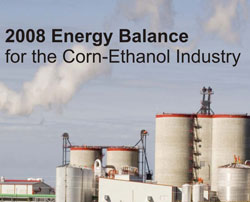A report released by USDA in June on the energy balance of ethanol plants is getting a second look this week, thanks to a post on the USDA blog.
 The second look is well deserved, since the report, titled “2008 Energy Balance for the Corn Ethanol Industry,” got less coverage than it deserves when it was first released. The findings of the report are significant because they specifically tackle the much-publicized claims of David Pimental that ethanol production results in a net energy loss. The USDA report updates the energy balance numbers by taking into account current practices used by both corn producers and ethanol processors that have led to increased efficiencies and concludes that “A dry grind ethanol plant that produces and sells dry distiller’s grains and uses conventional fossil fuel power for thermal energy and electricity produces nearly two times more energy in the form of ethanol delivered to customers than it uses for corn, processing, and transportation.”
The second look is well deserved, since the report, titled “2008 Energy Balance for the Corn Ethanol Industry,” got less coverage than it deserves when it was first released. The findings of the report are significant because they specifically tackle the much-publicized claims of David Pimental that ethanol production results in a net energy loss. The USDA report updates the energy balance numbers by taking into account current practices used by both corn producers and ethanol processors that have led to increased efficiencies and concludes that “A dry grind ethanol plant that produces and sells dry distiller’s grains and uses conventional fossil fuel power for thermal energy and electricity produces nearly two times more energy in the form of ethanol delivered to customers than it uses for corn, processing, and transportation.”
The report does concede that ethanol production was much less efficient 20-30 years ago, but that it has made tremendous gains, thanks to both increased corn yields and better production methods. “Over all, ethanol has made the transition from an energy sink, to a moderate net energy gain in the 1990s, to a substantial net energy gain in the present.”
As more plants start using biomass power instead of conventional fossil fuel for production, the energy balance could increase even more significantly, according to the report. “As processors master the logistics of handling bulky biomass, the energy balance ratio could reach 26 BTUs of ethanol per BTU of inputs used.”
Read the report here.

